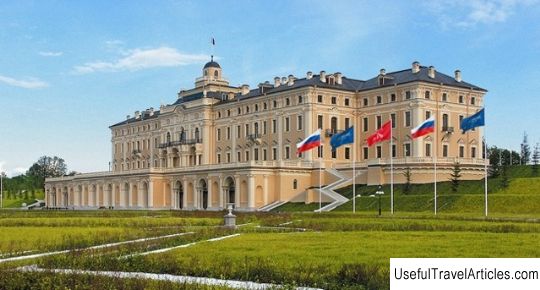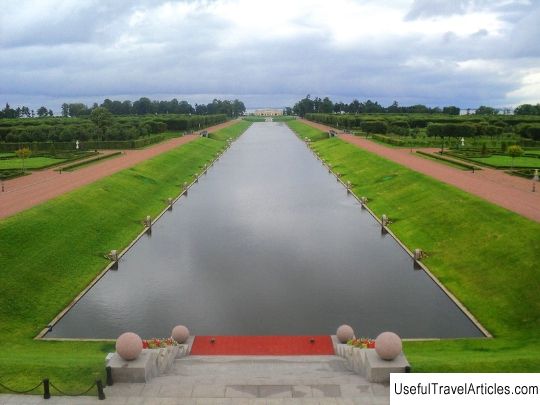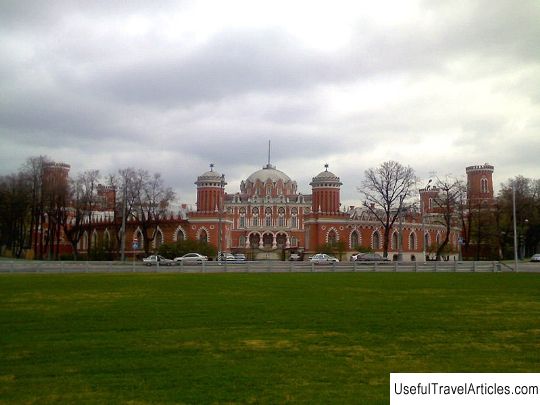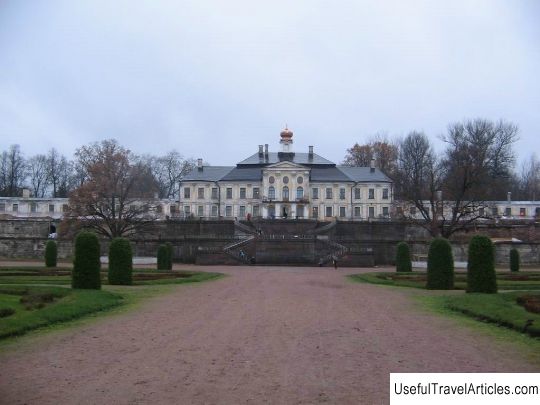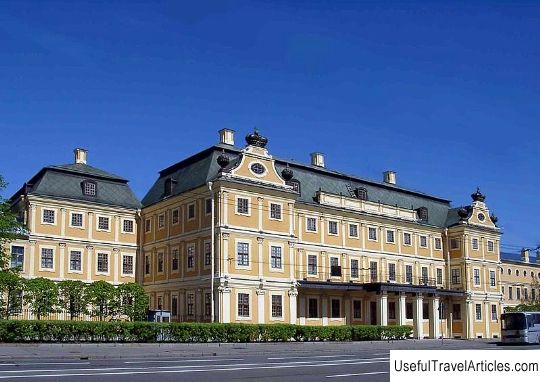Petrovsky Palace (Travel Palace) description and photos - Russia - St. Petersburg: Strelna
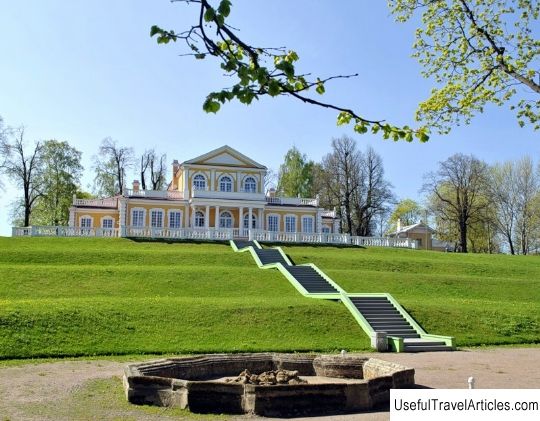
Petrovsky Palace (Travel Palace) description and photos - Russia - St. Petersburg: Strelna. Detailed information about the attraction. Description, photos and a map showing the nearest significant objects. Photo and descriptionThe Traveling Palace of Peter the Great is the earliest building in Strelna, preserved to this day from the times of Peter the Great. The palace is located near the coast of the Gulf of Finland, in the south of the Neva Bay, on a low elevation formed as a result of the retreat of glaciers, framed by ravines, next to the Strelka River. This wooden house, modest in size and decoration, was intended for the sovereign's stops during his constant trips from St. Petersburg to Kronstadt under construction. The construction of the palace began in 1716 (according to other sources, in 1710-1711). The first architect of the building is unknown. Initially, the Traveling Palace was erected as a large palace and park complex, which was supposed to approach, and, perhaps, overshadow the beauty of French Versailles. It was planned to arrange a navigable canal directly from St. Petersburg and to the palace. But these plans have been changed. In 1719-1720, the building was rebuilt and expanded at the request of the emperor, although by that time he had cooled to Strelna, having occupied Peterhof - his Northern Versailles. Despite the huge amount of water around (the Strelka and Kikenka rivers), Peter's desire to build a semblance of Versailles with fountains and cascades turned out to be unrealizable, since water refused to run into the fountains by gravity, and it was not easy with pumps in the early 1700s (the first steam engine appeared in the middle of the 17th century). On the contrary, in Peterhof, all the conditions for the construction of fountains were created by nature. The Travel Palace was repeatedly restored and rebuilt: wooden parts of the structure were replaced with new ones, completely dismantling and assembling the building, demolished and returned the balcony, cleaned and completed the rooms. Such restructuring took place in 1750, 1799 and in the period from 1837 to 1840. Famous architects took part in the life of the palace and the territory that surrounded it: B. Rastrelli, Voronikhin, Meyer. In 1750 Rastrelli rebuilt the aging palace, and in 1837 Meyer restored the 100-year-old palace, already taking into account its museum value, as a memory of the first emperor of Russia and his undertakings. In addition to the palace itself, the site included in itself a bee-garden, a vegetable garden, small fountains. Knowing Peter's passion for innovations, there is a legend that it was here that he planted potatoes brought from Holland for the first time in Russia. The palace territory has always been privately owned by the Romanov family, did not pass from hand to hand and therefore probably survived to this day. Although a hospital existed here for some time in the 18th century. In 1722, Peter I presented the Travel Palace and the territory to his daughter Elizabeth, and in 1797, Paul I presented the palace to his son Konstantin along with the Constantine Palace. In the 19th century, they experimented here in the cultivation of new varieties of potatoes and rare plants. After 1917, the palace was nationalized. During the Great Patriotic War, it was badly damaged (in October 1941, Strelninsky troops were landed near the palace). From 1944 until the early 1950s, the palace was in ruins, and after the restoration in 1951-1952, a nursery was located here. In 1981, it was decided to transfer the Traveling Palace of Peter I to the Peterhof State Museum-Reserve, but this transfer took place only in 1987. Since that time, the palace has been open to visitors. At present, the palace has been restored; in addition, the park and fountains have been restored (work of B. Rastrelli). The last restoration work was completed in 1999, and since then the museum in the palace is fully accessible to tourists. Among the exhibits you can see a lifetime portrait of Peter the Great, an imprint of his hand, a patchwork quilt, personally sewn by Empress Catherine I. The Traveling Palace today is also the main information center on the history of the village Strelna. It houses permanent exhibitions dedicated to the history of Strelna Palace and its owners, historical interiors of the 18th century, exhibitions are organized. but this entire transfer took place only in 1987. Since that time the palace has been open to visitors. At present, the palace has been restored; in addition, the park and fountains have been restored (work of B. Rastrelli). The last restoration work was completed in 1999, and since then the museum in the palace is fully accessible to tourists.Among the exhibits you can see a lifetime portrait of Peter the Great, an imprint of his hand, a patchwork quilt, personally sewn by Empress Catherine I. The Traveling Palace today is also the main information center on the history of the village Strelna. It houses permanent exhibitions dedicated to the history of the Strelna Palace and its owners, historical interiors of the 18th century, exhibitions are organized. but this entire transfer took place only in 1987. Since that time, the palace has been open to visitors. At present, the palace has been restored, in addition, the park and fountains have been restored (work of B. Rastrelli). The last restoration work was completed in 1999, and since then the museum in the palace is fully accessible to tourists.Among the exhibits you can see a lifetime portrait of Peter the Great, an imprint of his hand, a patchwork quilt, personally sewn by Empress Catherine I. The Traveling Palace today is also the main information center on the history of the village Strelna. It houses permanent exhibitions dedicated to the history of Strelna Palace and its owners, historical interiors of the 18th century, exhibitions are organized. Since that time, the palace has been open to visitors. At present, the palace has been restored, in addition, the park and fountains have been restored (work of B. Rastrelli). The last restoration work was completed in 1999, and since then the museum in the palace is fully accessible to tourists.Among the exhibits you can see a lifetime portrait of Peter the Great, an imprint of his hand, a patchwork quilt, personally sewn by Empress Catherine I. The Traveling Palace today is also the main information center on the history of the village Strelna. It houses permanent exhibitions dedicated to the history of the Strelna Palace and its owners, historical interiors of the 18th century, exhibitions are organized. Since that time, the palace has been open to visitors. At present, the palace has been restored; in addition, the park and fountains have been restored (work of B. Rastrelli). The last restoration work was completed in 1999, and since then the museum in the palace is fully accessible to tourists.Among the exhibits you can see a lifetime portrait of Peter the Great, an imprint of his hand, a patchwork quilt, personally sewn by Empress Catherine I. The Traveling Palace today is also the main information center on the history of the village Strelna. It houses permanent exhibitions dedicated to the history of Strelna Palace and its owners, historical interiors of the 18th century, exhibitions are organized. The last restoration work was completed in 1999, and since then the museum in the palace is fully accessible to tourists.Among the exhibits you can see a lifetime portrait of Peter the Great, an imprint of his hand, a patchwork quilt, personally sewn by Empress Catherine I. The Traveling Palace today is also the main information center on the history of the village Strelna. It houses permanent exhibitions dedicated to the history of the Strelna Palace and its owners, historical interiors of the 18th century, exhibitions are organized. The last restoration work was completed in 1999, and since then the museum in the palace is fully accessible to tourists.Among the exhibits you can see a lifetime portrait of Peter the Great, an imprint of his hand, a patchwork quilt, personally sewn by Empress Catherine I. The Traveling Palace today is also the main information center on the history of the village Strelna. It houses permanent exhibitions dedicated to the history of the Strelna Palace and its owners, historical interiors of the 18th century, exhibitions are organized. The Traveling Palace today is also the main information center on the history of the village of Strelna. It houses permanent exhibitions dedicated to the history of the Strelna Palace and its owners, historical interiors of the 18th century, exhibitions are organized. The Traveling Palace today is also the main information center on the history of the village of Strelna. It houses permanent exhibitions dedicated to the history of the Strelna Palace and its owners, historical interiors of the 18th century, exhibitions are organized.       We also recommend reading Abdul Rahman Mosque description and photos - Afghanistan: Kabul Topic: Petrovsky Palace (Travel Palace) description and photos - Russia - St. Petersburg: Strelna. |
